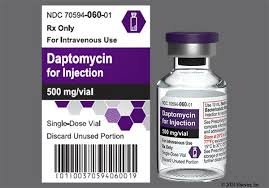
In the ever-evolving battlefield of infectious diseases, antibiotics have long been our stalwart defenders. However, the emergence of antibiotic-resistant pathogens has challenged our conventional weaponry, demanding innovative solutions. In this battle, daptomycin has emerged as a crucial player, showcasing remarkable efficacy against some of the most formidable bacterial foes. This article delves into the origins, mechanism of action, clinical applications, and future prospects of daptomycin in the ongoing war against antibiotic resistance.
Unveiling the Origins
Daptomycin, a cyclic lipopeptide antibiotic, was first discovered in the 1980s from the fermentation broth of Streptomyces roseosporus. Its unique structure, comprising a 13-membered cyclic peptide linked to a fatty acid side chain, sets it apart from conventional antibiotics. This distinct structure endows daptomycin with potent antimicrobial activity against a broad spectrum of Gram-positive bacteria, including notorious pathogens like Staphylococcus aureus, Enterococcus faecalis, and Streptococcus species.
Mechanism of Action: A Molecular Symphony
The mechanism of action of daptomycin is a testament to the elegance of nature’s chemical arsenal. Upon encountering the bacterial cell membrane, daptomycin inserts its lipid tail into the phospholipid bilayer, forming ion-permeable pores. This disruption leads to membrane depolarization, leakage of intracellular ions, and ultimately, bacterial cell death. Importantly, daptomycin’s mechanism of action differs from that of traditional antibiotics, targeting the bacterial membrane rather than intracellular processes. This unique mode of action contributes to its efficacy against multidrug-resistant pathogens, which often harbor mechanisms to thwart conventional antibiotics.
Clinical Applications: Triumphs in the Hospital Arena
Daptomycin’s clinical journey has been marked by notable successes, particularly in the realm of hospital-acquired infections. One of its shining achievements lies in the treatment of methicillin-resistant Staphylococcus aureus (MRSA) infections, a scourge of modern healthcare facilities. Daptomycin has demonstrated superior efficacy in treating complicated skin and soft tissue infections (cSSTIs) caused by MRSA, offering a lifeline to patients where other antibiotics falter.
Furthermore, daptomycin has proven its mettle in combating bloodstream infections, including those caused by vancomycin-resistant Enterococcus (VRE). These infections, notorious for their high mortality rates, pose formidable challenges to clinicians. However, daptomycin’s potent bactericidal activity and favorable safety profile have positioned it as a cornerstone of antimicrobial therapy in such dire scenarios.
Challenges and Considerations
Despite its remarkable attributes, daptomycin is not without limitations and considerations. Resistance, albeit rare, has been reported, underscoring the importance of judicious antibiotic use to mitigate the emergence of resistant strains. Additionally, daptomycin’s inability to penetrate the outer membrane of Gram-negative bacteria restricts its utility against this class of pathogens. Moreover, its intravenous administration and potential for adverse effects, such as myopathy and eosinophilic pneumonia, warrant careful patient monitoring and dose adjustments.
Future Horizons: Expanding the Armamentarium
As the battle against antibiotic resistance rages on, the quest for novel therapeutic strategies continues unabated. In this context, ongoing research endeavors aim to harness the full potential of daptomycin while addressing its limitations. Strategies such as combination therapy, utilizing daptomycin in tandem with other antibiotics or adjuvants, hold promise in enhancing efficacy and overcoming resistance mechanisms. Furthermore, the exploration of alternative administration routes, such as inhalation or topical formulations, may broaden daptomycin’s clinical applicability and accessibility.
Moreover, the development of next-generation lipopeptides inspired by daptomycin’s structure represents a frontier of innovation in antibiotic discovery. These analogs, designed for enhanced potency, spectrum of activity, and pharmacokinetic properties, may herald a new era in the fight against multidrug-resistant pathogens.
Conclusion
Daptomycin stands as a beacon of hope in our battle against antibiotic-resistant pathogens, exemplifying the resilience of scientific ingenuity in the face of microbial adversity. Its unique mechanism of action, clinical efficacy, and ongoing evolution underscore its significance in modern antimicrobial therapy. However, as we navigate the complexities of infectious diseases and antimicrobial stewardship, continued research and vigilance are paramount to ensure the enduring efficacy of daptomycin and safeguard it as a cornerstone of our antibiotic armamentarium.
